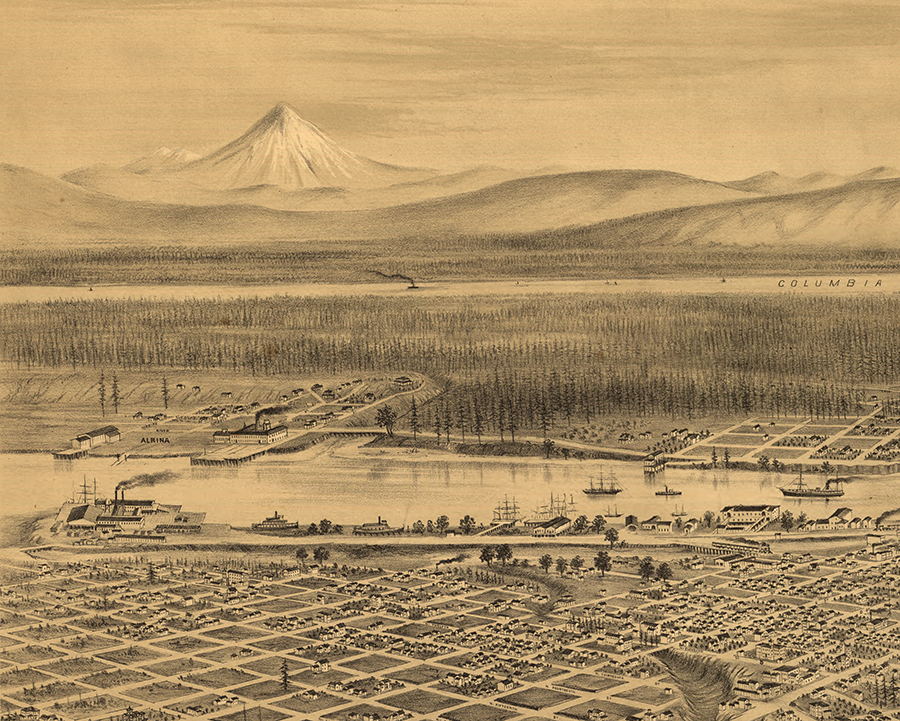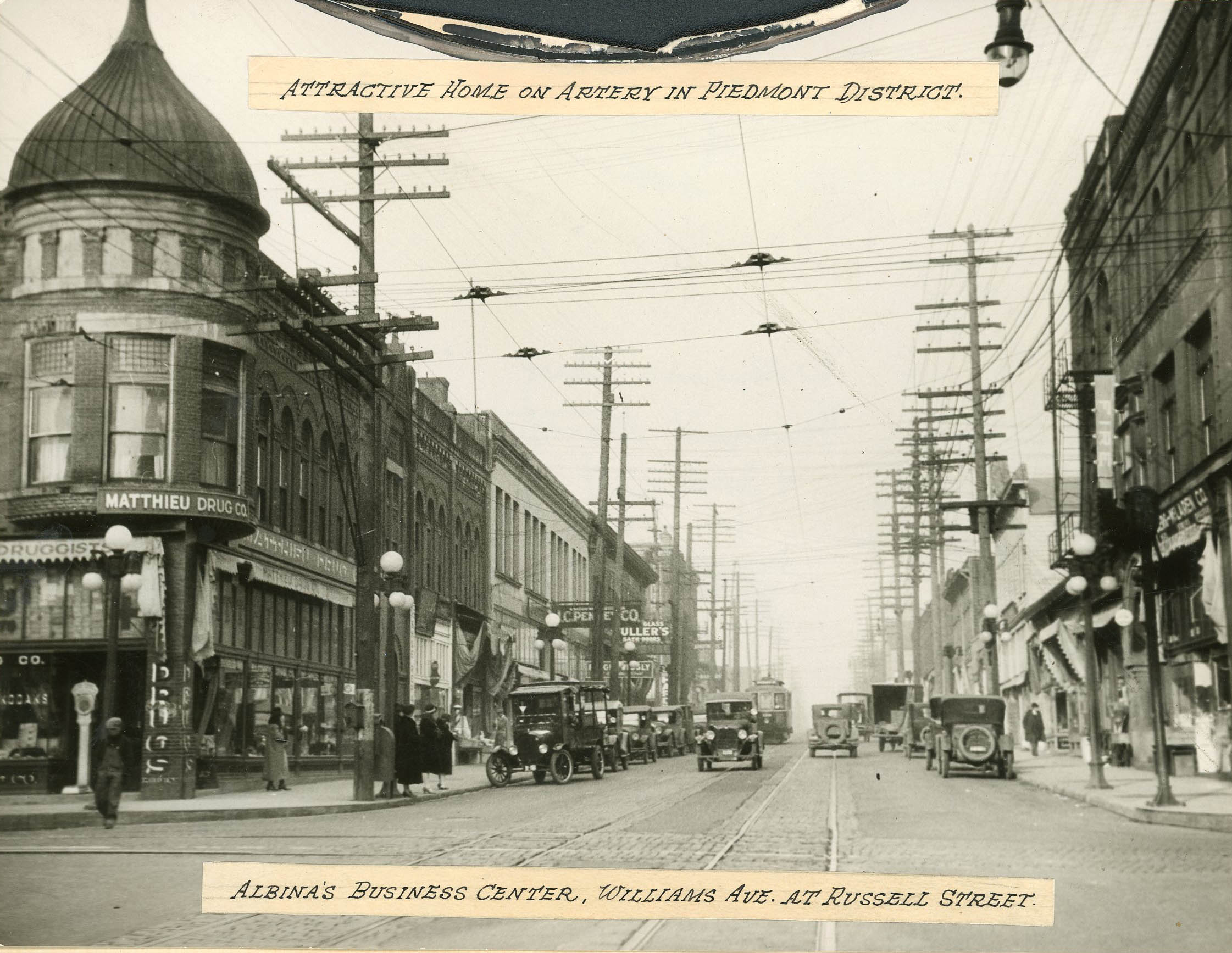The Albina District

The town of Albina in 1879
Albina is a district of neighborhoods in Portland, Oregon. It was located on a donation land claim owned by J.L. Loring and Joseph Delay. The land was later sold to attorney William Winter Page. The original town site was named after the wife and daughter of William Page, who were both named Albina. In 1872, Page sold the land to Edwin Russell, manager of the Portland branch of the Bank of British Columbia, and George H. Williams, former senator, U.S. Attorney General, and future mayor of Portland. Today Northeast Russell Street and Williams Avenue carry their names.
Albina was platted in 1872 and the new town filed in April 1873 by Edwin Russell, William Page, and George Williams.
The townsite was originally developed along the railroad tracks in lower Albina and to the east along Russell street. The first subdivision was also platted in 1873, creating residential lots that extended east of the current Martin Luther King (MLK) Blvd. and north past NE Morris street.
In 1880, there were 163 people living in Albina. In 1881, a large influx of Volga Germans began populating Albina.
In March 1882, construction of the Oregon Railroad and Navigation Company (OR&NC) "Great Depot" began. The depot included car and machine shops and a vast rail yard. The development caused both the population and the property values in Albina to soar. Five railroads planned to locate their terminal at Albina. In 1898, the Union Pacific Railroad purchased a majority stake in OR&NC and in 1936, absorbed the company completely.
By 1885, the primary businesses in Albina were Portland Flour Mills, Albina Sawing and Planing Mills, Oregon Iron Works, the Montgomery grain dock and OR&NC rail operations.

Matthieu Drug Company, 1 North Russell Street, Portland OR
Albina Business District at North Williams and Russell Street 1927.
Albina was platted in 1872 and the new town filed in April 1873 by Edwin Russell, William Page, and George Williams. Albina was named after Mrs. Albina Page, the wife of William Page.
Lower Albina remained one of the few places African American families could live or work in the Portland area until the eve of WWII. Shipbuilding yards along the Columbia River drew thousands of workers from around the United States, increasing Portland’s black population from 1,931 in 1940 to more than 20,000 in 1945. Most of the newcomers lived in Vanport, an integrated community housing development along the Columbia River created to accommodate shipyard workers. When Vanport was destroyed by the Columbia River flood of 1948, over 16,000 people were displaced. Black residents who lost their homes were faced with a difficult choice: return to their hometowns or try to resettle in the very few parts of Portland available to them. Homeless and unemployed, the new residents of Albina mostly rented rapidly aging homes or apartments vacated by white Portlanders bound for the suburbs.

1962
Albina Business District at North Williams and Russell Street 1927.
Albina was platted in 1872 and the new town filed in April 1873 by Edwin Russell, William Page, and George Williams. Albina was named after Mrs. Albina Page, the wife of William Page.
Lower Albina remained one of the few places African American families could live or work in the Portland area until the eve of WWII. Shipbuilding yards along the Columbia River drew thousands of workers from around the United States, increasing Portland’s black population from 1,931 in 1940 to more than 20,000 in 1945. Most of the newcomers lived in Vanport, an integrated community housing development along the Columbia River created to accommodate shipyard workers. When Vanport was destroyed by the Columbia River flood of 1948, over 16,000 people were displaced. Black residents who lost their homes were faced with a difficult choice: return to their hometowns or try to resettle in the very few parts of Portland available to them. Homeless and unemployed, the new residents of Albina mostly rented rapidly aging homes or apartments vacated by white Portlanders bound for the suburbs.

1962
1962: The Hill Block Building where Matthieu Drug was located. The building was the cornerstone of the Albina district and featured a turret with an onion shaped roof. The brick building was built in 1910 and survived until 1975 when it was torn down for Emmanuel Hospital expansion that would never take place. A sad part of history within the Albina district. The roof of the cupola was relocated to Dawson Park in 1978 and now resides on top of a gazebo.
The photograph above, taken in April, 1975 shows the cupola from the Hill Block Building being removed. The building was constructed by the first mayor of Albina, Charles Hill, in 1910. It remained the center of Lower Albina's business district at the Northwest corner of N. Williams & Russell until April 1975, shortly before it was demolished as part of a plan to expand Emanuel Hospital. Federal funds for the expansion fell short and that parcel of land remains vacant to this day. The cupola was relocated to Dawson Park, a few blocks to the north, and currently sits atop a gazebo.
References
The Volga Germans in Portland, A Short History of Albina Copyright © 1998-2020 Steven H. Schreiber


Comments
Post a Comment